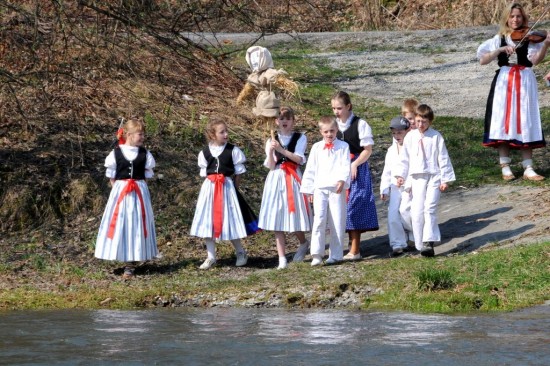
Her name alone means death, and every year, as winter winds down and springs looms on the horizon, in certain parts of the Czech Republic, Poland, Lithuania, and Slovakia, she is burnt or drown in effigy.
Her name is Marzanna, and this seemingly cruel act is done for many reasons: As an offering to ensure a good harvest in the year ahead, as a celebration for moving past the demons and nightmares associated with winter, as a rite associated with the death and rebirth of nature and the seasons, and as a celebration of the coming of spring, a season represented by the Slavic god, Jarilo.
In Japan, at the end of March and beginning of April is the Cherry Blossom Festival. In Thailand, the Songkran Water Festival, involving colorful street parades thronged by onlookers spraying and shooting water into the air, falls shortly after the Spring Equinox. In northern India, there is the Holi Festival, a vibrant Hindu festival in which the faithful throw colored powder meant to represent the seasons many hues at one another. In central Asian countries like Kyrgyzstan, there is Nowruz, also known as the Persian New Year, which involves elaborate dancing and costumes. And there are many more colorful springtime festivals.
But why in Eastern Europe does the focus of the festival seem to be so much darker?
Well, it could be because winters are colder here, and one cannot celebrate spring without reflecting upon just how hard things were during the winter.
As Wikipedia notes, “it was believed that burning an effigy representing the goddess of death would remove any results of her presence (i.e., the winter) and thus bring about the coming of spring.” Which makes Marzanna sound like a vengeful version of Ground Hog’s Day.
“Since Marzanna represents the death of Winter, the Sunday on which the Marzanna celebrations take place is sometimes called Death Sunday,” notes the Wandering in Warsaw blog. “On this day a straw or rag effigy of Marzanna is constructed, sometimes by school children. The effigy is imbued with the negative qualities of the long, cold winter.”
Part of the mystery of Marzanna’s dark characteristics may lie in the origin of her name. In Polish mara means phantom, vision, or hallucination. In Latin there is the root mar or mor, meaning death. The goddess Marzanna also originally may have been connected to the Roman god of war, Mars, who was known under a variety of names, including Marmor, Mamers, and Mamurius Veturius. Still other theories suggest a link to the Russian mor, meaning pestilence, or mare, an evil spirit in Germanic and Slavic folklore that is associated with nightmares and sleep paralysis.
Marzanna effigies can be the size of dolls, or life-sized. The figures are usually made of straw or corn stalks, wrapped in white cloth, and decorated with ribbons and necklaces. Typically, children play a critical role, and are the dark goddesses’ true executioners. Often the burning or drowning of Marzanna is carried out by kindergarten and elementary school children on school field trips. The children make the effigies themselves. The blog, Emily’s Guide to Krakow, has a number of colorful photographs showing school children chucking their Marzanna dolls into a swiftly-flowing stream.
Writer Tom Galvin, writing in the Warsaw Voice, in 1999, describes the event as such:
…A large figure of a woman made from various rags and bits of clothing…is thrown into a river on the first day of the spring calendar. Along the way, she is dipped into every puddle and pond … Very often she is burned along with herbs before being drowned and a twin custom is to decorate a pine tree with flowers and colored baubles to be carried through the village by the girls.
And the ceremony does not end there. As Galvin explains:
There are…many superstitions…you can’t touch Marzanna once she’s in the water, you can’t look back at her, and if you fall on your way home you’re in big trouble. One, or a combination of any of these can bring the usual dose of sickness and plague.
As might be expected, a festival associated with such degrees of paganism has not always been regarded highly by the Catholic Church. “Do not allow the superstitious Sunday custom,” the Synod of Poznań instructed the Polish clergy, in 1420. “Do not permit them to carry around the effigy they call Death and drown in puddles.”
But the custom prevailed, and 600 years later, it still prevails.
As is portrayed in comments on the Spring Festival Drowning Marzanna 2014 Facebook page (referring to the specific Marzanna drowning that happened at the River Kelvin, north of Glasgow, in the United Kingdom), the event, despite the gloom associated with it, remains a joyous occasion.
“Dear All, thank you for being part of today’s drowning!” wrote one attendee. “We will post photographs and a video on our blog soon…”









